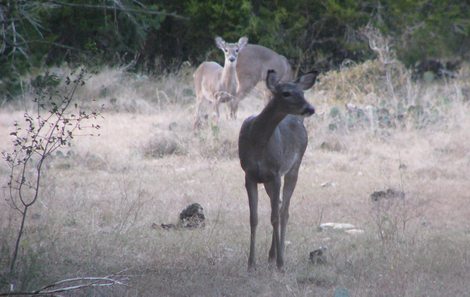Deer hunting season takes place in the fall for one primary reason — to remove excess animals from the landscape prior to winter. When it comes to the deer carrying capacity, winter is THE limiting factor. As a result, proper harvest is essential for the deer herd found on your property, their habitat, and your overall deer management program. With the the onset of winter just around the corner, do not forget to harvest deer, especially does, as early as possible.
I mention this now because as the end of the year approaches, the time that many hunters have to head to the field decreases. The Christmas and New Year’s holidays can take away from your days in the field. It’s hard to harvest deer and reach harvest quotas if hunters can not make it out to the ranch.
With winter officially kicking off on December 21, time is running out to get the deer population on your property down to its winter carrying capacity. If you are not sure what the proper deer carrying capacity for your ranch is, then you first need to contact a wildlife biologist in your area. Carrying capacity refers to the number of deer that a property can over-winter.
It varies by ecological region, habitat type, and ranch, but it is the first piece of information you need to properly manage any deer herd. If the proper density for a ranch is 1 deer for every 10 acres, then a 1,000 acre ranch can over-winter 100 white-tailed deer. Excess animals, if they exists, must be removed annually to ensure the health of the remaining deer.
With much of the deer season already gone, why should you always aim to harvest deer as early as possible in the season? Below I have listed three good reasons why early doe harvest is important for your deer management program.
Food — This is the primary reason you need to harvest deer early. Natural food sources will decrease throughout winter. If deer surveys estimate that 20 animals need to be removed from the ranch, why let those animals consume limited food resources for an additional month or two prior to harvesting them? Removing them early leaves the natural foods those “dead deer walking” would have consumed for the remaining animals, which keeps your deer herd healthy and strong. If a supplemental feeding program is in place, the same concept applies and you save money.
Buck to Doe Ratio — Bucks will continue to rut and breed does until all does are covered. If a large number of does must be removed, it is best to remove them early. If most of the does are bred early in the season, then bucks can save valuable energy and body mass. In addition, whitetail bucks become more visible because there are fewer does available in the woods. Maintain your buck to doe ratio and the overall health of your herd.
Fawning Dates — As mentioned above, harvesting excess does early in the season allows bucks to cover the remaining does much quicker. Fewer does per buck results in more does being bred on their first cycle. This, in turn, means more fawns are born earlier in the year. These early-born fawns will be larger before the other stress period for white-tailed deer sets in, summer. Early-born fawns means more food for lactating does, resulting in increased fawn production.

What about nursing fawns early in the season? Will taking lactating does hinder growth and development in these young deer?
That is a good question, so check this out for my answer on harvesting does with fawns.